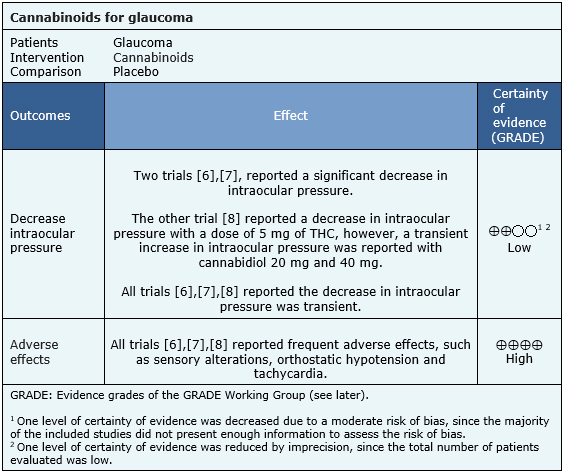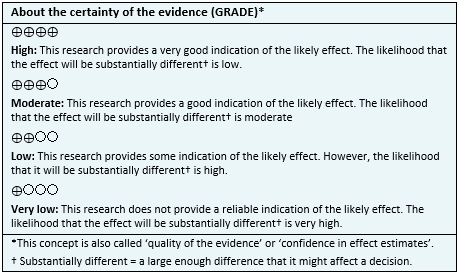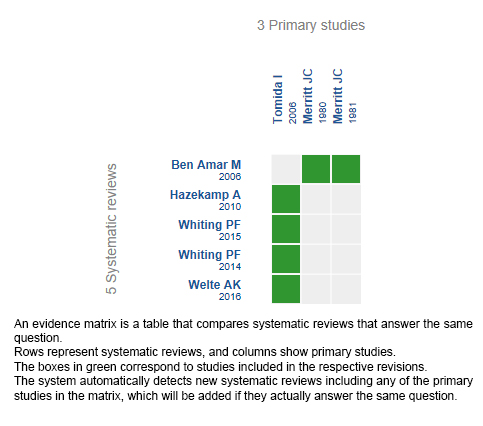Resúmenes Epistemonikos
← vista completaPublicado el 24 de enero de 2018 | http://doi.org/10.5867/medwave.2018.01.7144
¿Tienen algún rol los cannabinoides en el control del glaucoma?
Do cannabinoids play a role in the control of glaucoma?
Abstract
INTRODUCTION The use of cannabinoids in diverse clinical conditions is today a subject of debate. Its use has been proposed for the control of glaucoma. However, there is controversy about its real effectiveness and safety.
METHODS To answer this question we used Epistemonikos, the largest database of systematic reviews in health, which is maintained by screening multiple information sources, including MEDLINE, EMBASE, Cochrane, among others. We extracted data from the systematic reviews, reanalyzed data of primary studies and generated a summary of findings table using the GRADE approach.
RESULTS AND CONCLUSIONS We identified five systematic reviews including three studies overall, all of them randomized controlled trials. We concluded that although cannabinoids could decrease intraocular pressure, the effect would be transient and associated with frequent adverse effects.
Problem
Glaucoma is a multifactorial optic neuropathy, often related to an increase in intraocular pressure (IOP). The permanently elevated intraocular pressure produces a slow and progressive damage in the optic nerve, generating different sequelae in the visual field and eventually it can lead to irreversible blindness. Although the elevation of intraocular pressure is present in most patients, there is a group of patients who develop glaucoma with normal pressure.
Today there are different medical therapies for the treatment of glaucoma, such as topical betablockers and prostaglandin analogues. The use of cannabinoids has been proposed, since its administration is associated with a decrease in intraocular pressure, through an effect on the production and exit of aqueous humor mediated by the activation of CB1 receptors. Also, neuroprotective properties on the optic nerve have been proposed. However, its actual clinical role is still controversial.
Methods
To answer the question, we used Epistemonikos, the largest database of systematic reviews in health, which is maintained by screening multiple information sources, including MEDLINE, EMBASE, Cochrane, among others, to identify systematic reviews and their included primary studies. We extracted data from the identified reviews and reanalyzed data from primary studies included in those reviews. With this information, we generated a structured summary denominated FRISBEE (Friendly Summary of Body of Evidence using Epistemonikos) using a pre-established format, which includes key messages, a summary of the body of evidence (presented as an evidence matrix in Epistemonikos), meta-analysis of the total of studies when it is possible, a summary of findings table following the GRADE approach and a table of other considerations for decision-making.
|
Key messages
|
About the body of evidence for this question
|
What is the evidence. |
We found five systematic reviews [1],[2],[3],[4],[5] including three primary studies overall [6],[7],[8], all of which correspond to randomized controlled trials. |
|
What types of patients were included* |
All trials included adult patients with glaucoma [6],[7],[8], with average age over 50 years. Only one trial specified the type of glaucoma (primary open-angle glaucoma) [8]. Two trials [7],[8], included patients with intraocular hypertension. |
|
What types of interventions were included* |
One trial [8] used sublingual cannabinoid spray (Sativex®) at doses of 5, 20 and 40 mg. Another trial [6] used smoked marijuana with 2% tetrahydrocannabinol (THC), while the last trial [7] used marijuana in 0.01%, 0.05%, and 0.1% eye drops.All trials compared against placebo or standard treatment. |
|
What types of outcomes |
The different systematic reviews identified [1],[2],[3],[4],[5] grouped the outcomes as follows:
Two trials [7],[8] analyzed the duration of the intraocular pressure decrease, while in the other trial this variable was not reported [6]. |
* The information about primary studies is extracted from the systematic reviews identified, unless otherwise specified.
Summary of Findings
The information on the effects of cannabinoids for glaucoma is based on three randomized trials [6],[7],[8], which include 32 patients in total. All of the trials [6],[7],[8], reported intraocular pressure and adverse effects, and two of them [7],[8] specified the duration of the decrease in intraocular pressure. None of the trials reported decreased visual acuity or visual field deterioration. The summary of findings is the following:
- The use of cannabinoids for glaucoma could be associated with a transient decrease in intraocular pressure, but the certainty of the evidence is low.
- The use of cannabinoids for glaucoma leads to frequent adverse effects. The certainty of the evidence is high.


Other considerations for decision-making
|
To whom this evidence does and does not apply |
|
| About the outcomes included in this summary |
|
| Balance between benefits and risks, and certainty of the evidence |
|
| Resource considerations |
|
| What would patients and their doctors think about this intervention |
|
|
Differences between this summary and other sources |
|
| Could this evidence change in the future? |
|
How we conducted this summary
Using automated and collaborative means, we compiled all the relevant evidence for the question of interest and we present it as a matrix of evidence.

Follow the link to access the interactive version: Cannabinoids for glaucoma
Notes
The upper portion of the matrix of evidence will display a warning of “new evidence” if new systematic reviews are published after the publication of this summary. Even though the project considers the periodical update of these summaries, users are invited to comment in Medwave or to contact the authors through email if they find new evidence and the summary should be updated earlier.
After creating an account in Epistemonikos, users will be able to save the matrixes and to receive automated notifications any time new evidence potentially relevant for the question appears.
This article is part of the Epistemonikos Evidence Synthesis project. It is elaborated with a pre-established methodology, following rigorous methodological standards and internal peer review process. Each of these articles corresponds to a summary, denominated FRISBEE (Friendly Summary of Body of Evidence using Epistemonikos), whose main objective is to synthesize the body of evidence for a specific question, with a friendly format to clinical professionals. Its main resources are based on the evidence matrix of Epistemonikos and analysis of results using GRADE methodology. Further details of the methods for developing this FRISBEE are described here (http://dx.doi.org/10.5867/medwave.2014.06.5997)
Epistemonikos foundation is a non-for-profit organization aiming to bring information closer to health decision-makers with technology. Its main development is Epistemonikos database (www.epistemonikos.org).
Potential conflicts of interest
The authors do not have relevant interests to declare.

